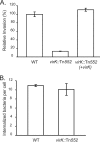Characterization of a Campylobacter jejuni VirK protein homolog as a novel virulence determinant
- PMID: 19797067
- PMCID: PMC2786475
- DOI: 10.1128/IAI.00528-09
Characterization of a Campylobacter jejuni VirK protein homolog as a novel virulence determinant
Abstract
Campylobacter jejuni is a leading cause of food-borne illness in the United States. Despite significant recent advances, its mechanisms of pathogenesis are poorly understood. A unique feature of this pathogen is that, with some exceptions, it lacks homologs of known virulence factors from other pathogens. Through a genetic screen, we have identified a C. jejuni homolog of the VirK family of virulence factors, which is essential for antimicrobial peptide resistance and mouse virulence.
Figures






Similar articles
-
Identification of Campylobacter jejuni genes involved in its interaction with epithelial cells.Infect Immun. 2010 Aug;78(8):3540-53. doi: 10.1128/IAI.00109-10. Epub 2010 Jun 1. Infect Immun. 2010. PMID: 20515930 Free PMC article.
-
Campylobacter jejuni: a brief overview on pathogenicity-associated factors and disease-mediating mechanisms.Int J Med Microbiol. 2010 Apr;300(4):205-11. doi: 10.1016/j.ijmm.2009.07.002. Epub 2009 Aug 8. Int J Med Microbiol. 2010. PMID: 19665925 Review.
-
CapC, a Novel Autotransporter and Virulence Factor of Campylobacter jejuni.Appl Environ Microbiol. 2018 Aug 1;84(16):e01032-18. doi: 10.1128/AEM.01032-18. Print 2018 Aug 15. Appl Environ Microbiol. 2018. PMID: 29915112 Free PMC article.
-
Quantitative Proteomics of Intracellular Campylobacter jejuni Reveals Metabolic Reprogramming.PLoS Pathog. 2012;8(3):e1002562. doi: 10.1371/journal.ppat.1002562. Epub 2012 Mar 8. PLoS Pathog. 2012. PMID: 22412372 Free PMC article.
-
Campylobacter jejuni.Lett Appl Microbiol. 2005;41(4):297-302. doi: 10.1111/j.1472-765X.2005.01788.x. Lett Appl Microbiol. 2005. PMID: 16162134 Review.
Cited by
-
Campylobacter jejuni genes Cj1492c and Cj1507c are involved in host cell adhesion and invasion.Gut Pathog. 2020 Feb 11;12:8. doi: 10.1186/s13099-020-00347-8. eCollection 2020. Gut Pathog. 2020. PMID: 32064001 Free PMC article.
-
Host epithelial cell invasion by Campylobacter jejuni: trigger or zipper mechanism?Front Cell Infect Microbiol. 2012 Mar 5;2:25. doi: 10.3389/fcimb.2012.00025. eCollection 2012. Front Cell Infect Microbiol. 2012. PMID: 22919617 Free PMC article. Review.
-
Complete genome sequence of the marine fish pathogen Vibrio anguillarum harboring the pJM1 virulence plasmid and genomic comparison with other virulent strains of V. anguillarum and V. ordalii.Infect Immun. 2011 Jul;79(7):2889-900. doi: 10.1128/IAI.05138-11. Epub 2011 May 16. Infect Immun. 2011. PMID: 21576332 Free PMC article.
-
The Periplasmic Chaperone Network of Campylobacter jejuni: Evidence that SalC (Cj1289) and PpiD (Cj0694) Are Involved in Maintaining Outer Membrane Integrity.Front Microbiol. 2017 Mar 28;8:531. doi: 10.3389/fmicb.2017.00531. eCollection 2017. Front Microbiol. 2017. PMID: 28400767 Free PMC article.
-
How a sugary bug gets through the day: recent developments in understanding fundamental processes impacting Campylobacter jejuni pathogenesis.Gut Microbes. 2012 Mar-Apr;3(2):135-44. doi: 10.4161/gmic.19488. Epub 2012 Mar 1. Gut Microbes. 2012. PMID: 22555465 Free PMC article. Review.
References
-
- Allos, B. M. 2001. Campylobacter jejuni infections: update on emerging issues and trends. Clin. Infect. Dis. 32:1201-1206. - PubMed
-
- Bachtiar, B. M., P. J. Coloe, and B. N. Fry. 2007. Knockout mutagenesis of the kpsE gene of Campylobacter jejuni 81116 and its involvement in bacterium-host interactions. FEMS Immunol. Med. Microbiol. 49:149-154. - PubMed
Publication types
MeSH terms
Substances
LinkOut - more resources
Full Text Sources
Medical
Molecular Biology Databases

